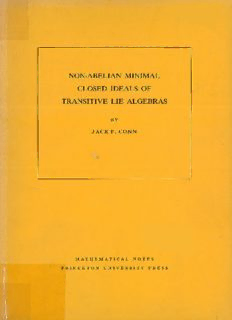
Non-Abelian Minimal Closed Ideals of Transitive Lie Algebras PDF
Preview Non-Abelian Minimal Closed Ideals of Transitive Lie Algebras
NON-ABELIAN MINIMAL CLOSED IDEALS OF 'TRANSITIVE LIE ALGEBRAS BY JACK F. CONN ·' MATHEMATICAL NOTES PRINCETON UNIVERSITY PRESS NON-ABELIAN MINIMAL CLOSED IDEALS OF TRANSITIVE LIE ALGEBRAS by Jack F. Conn Princeton University Press and University of Tokyo Press Princeton, New Jersey 1981 Copyright© 1981 by Princeton University Press All Rights Reserved Published in Japan Exclusively by University of Tokyo Press in other parts of the world by Princeton University Press Printed in the United States of America by Princeton University Press, Princeton, New Jersey Library of Congress Cataloging in Publication Data will be found on the last printed page of this book Table of Contents Intro due tion 1 1. Preliminaries 15 2. Derivations of Transitive and Simple Lie Algebras 65 3. Siznple Algebras with Parameters 95 4. Closed Ideals of Transitive Lie Algebras 110 5. Miniznal Closed Ideals of Complex Type 152 References 217 Preface Apart from their inherent interest as algebraic structures, transitive Lie algebras play an essential role in any study of the integrability problem for transitive pseudogroup structures on manifolds. This monograph presents, in an essentially self-contained way, work on the structure of transitive Lie algebras and their non-abelian minimal closed ideals. Many of the results contained here have simple differential-geometric interpretations, and bear directly upon the integrability problem. It is a pleasure to acknowledge the constant encouragement and advice given me by Hubert Goldschmidt and Donald C. Spencer; this work owes much to their suggestions and trenchant criticism. Victor Guillemin generously provided an unpublished manuscript which afforded some essential new results. I would also like to thank Vivian Davies whose typing is responsible for the attractive appearance of the finished manuscript. The Institute for Advanced Study provided gracious hospitality to the author during a portion of this research, which was partially supported by Grant MCS77-187Z3 from the National Science Foundation. Jack F. Conn Pasadena, California 1 Introduction Transitive pseudogroups of local diffeomorphisms preserving geometric structures on manifolds have been studied by many authors; the origins of this subject are classical, and may be said to lie in the , works of Sophus Lie and Elie Cartan. The structure of such a pseudo- group r acting on a manifold X is reflected in the structure of the Lie algebra of formal infinitesimal transformations of r, that is to say, those formal vector fields on X which are formal solutions to the linear partial differential equation which defines the infinitesimal trans- formations of r. The Lie algebras of formal vector fields obtained in this way provide examples of what are now known as transitive Lie algebras; such Lie algebras are, in general, infinite-dimensional. The study of transitive Lie algebras was first placed on a strictly algebraic basis by the pa:EJer {[16]) of V. W. Guillemin and S. Sternberg. Subsequent work of Guillemin {[ 11 ]) characterized transitive Lie algebras as linearly compact topological Lie algebras which satisfy the descending chain condition on closed ideals, and established the existence of a Jordan-Hc5lder decomposition in such Lie algebras. This latter result is a weak analogue of the Levi decomposition for finite-dimensional Lie algebras. Several authors have since adopted this abstract algebraic viewpoint for the study of transitive algebras; one result of their work has been the rigorous and progressively simplified proofs ([ 12], [ 14], [15], [21], [23], [29]), in the category of transitive Lie algebras, of the classification of the infinite-dimensional primitive Lie pseudogroups given by E. Cartan {[ 3]). We shall make use of this classification in the present work. 2 Transitive Lie algebras have been studied also to provide insight into the behavior of the integrability problem for transitive pseudogroup structures. A precise formulation of this problem may be found in ([ 20] ); for surveys of the principal results concerning this problem, we refer the reader to ([ 8]) and the introduction of ([9]). The role played by real transitive Lie algebras and their non-abelian minimal closed ideals in the integrability problem was elucidated by H. Goldschmidt and D. C. Spencer ([9]). In our present work, we give a complete algebraic description of the structure of these non-abelian minimal closed ideals. Our study was undertaken as a tool for the investigation of the integrability problem, and is an essential element in the proof of Conjecture III of ([ 9]) as outlined in ([ 8]) and in greater detail in the introduction to ([31]). The proof of this conjecture implies, in particular, that the integrability problem is solved for all transitive Lie pseudogroups acting on lRn which contain the translations, a fortiori for all flat pseudo groups. In an attempt to prove Conjecture I of ([ 9]) following the outline suggested there, we found that the geometry of pseudo-complex structures (induced structures on real submanifolds of complex n-space <Jf) was expressed in the structure of non-abelian minimal closed ideals of complex type in real transitive Lie algebras. From this observation, we were able to construct simple counterexamples to Conjectures I and II of ([9]) involving such closed ideals; these counterexamples have appeared in our note ([ 4] ). Our presentation follows through Section four the outline given in §13 of ([9]); this part of the present work contains our results on the structure of non-abelian minimal closed ideals of real type which are used by Goldschmidt in ([31]) to prove Conjecture I of ([9]) for these closed ideals. In a sequel to ([ 31] ), Goldschmidt will present a proof of Theorem 9 of
Description: